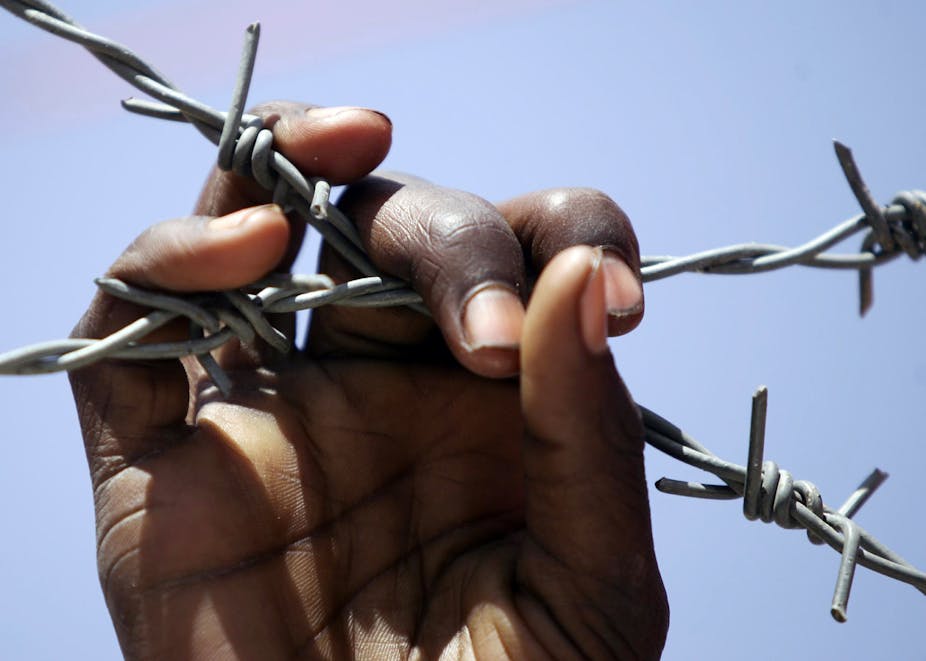The Commonwealth Ombudsman yesterday launched an investigation into rising rates of self-harm among detainees of Australia’s immigration detention centres, after it emerged that 50 instances of cutting, burning and other self abuses occurred in the first week of July alone.
Monash University’s Professor of Psychiatry, Louise Newman – who also chairs the committee advising the Immigration Department on health and safety – explains why action on asylum seeker health is long overdue.
How prevalent is self-harm in detention centres?
Part of the problem is we don’t have clear data. But we can certainly say there has been a significant increase in the rates of all self harming, with at least 50 reported episodes in the first week of July.
We’ve had outbreaks of self-harm in groups of people and we’ve had five suicides within the system since September last year. Three of these deaths occurred in Villawood detention centre in Sydney.
How severe is the self-harm?
It includes cutting, burning, lip sewing, and so on. Hunger strikes are not defined as self-harm.
What would you say is the cause of much of this self-harm? Does it stem from the trauma of the detainee’s past or is it, as detention centre operator Serco has claimed, being used as a bargaining tool?
I think it’s a combination of many factors. It’s deeply concerning if Serco or any provider labels all this behaviour as politically-motivated manipulation.
This is a very distressed and vulnerable population group. We have many people who are survivors of psychical and psychological torture who, according to the government’s own policies, should not be detained.
We have young people separated from their families; we have desperate individuals. We need to be a bit more reflective and look at the underlying contributing factors.
Of course, in these sorts of environments people will want to communicate their frustrations, their anger and the sense of despair they feel. And they’ll use quite graphic and sometimes very confronting ways to do that, such as sewing up their mouth. This symbolically says, “I have no voice in this situation”; it’s an expression of powerlessness.
It’s very concerning if the government and detention providers can’t look at the underlying factors in their system that contribute to this despair.
These factors include overcrowding, increased processing time (which has been the situation now for many months) and the detention of people with psychological vulnerabilities, who fear being detained indefinitely.
Australia’s mandatory detention policy requires all unauthorised arrivals to be detailed regardless of age, sickness, mental health, and so on. And that detention can be indefinite.
How has detainee health changed over the past ten years?
We actually had a honeymoon period with some important reforms after the Baxter and Woomera situation ten years ago.
What’s concerning is we seem to be regressing to the sorts of situations that contributed to the terrible protest and self-harm we saw in those days. I would hope that we’ve learnt more from those events.
The research that our group conducted, and others have conducted since then, has linked mental deterioration with lengths of time in detention – that’s something we need to consider very closely.
We know, from reviews into Baxter and Woomera, how easy it is for these systems to become deeply dysfunctional, with a culture of blaming, a culture of denigrating detainees and a culture that overlooks the fact that many of these people are mentally unwell and highly distressed.
The most graphic example we had many years ago is the case of Cornelia Rau, who happened to be an Australian resident. She was detained and happened to have a very severe paranoid schizophrenic illness that was unrecognised. The system decided she was acting in a manipulative way and detained her in solitary confinement, without treatment.
We need to be very mindful that this can happen in our detention system. We need to put in place the appropriate checks and balances so that people who are ill are recognised as such and are placed in appropriate community locations for support and treatment.
What types structural changes do we need for improved asylum-seeker health in the long term?
We need more than just structural reform; we need legal reform. We need to use the Ombudsman’s investigation to rethink the framework of our immigration detention policies, particularly the policy of mandatory detention.
Detention, according to the government’s own policy, is a matter of last resort. Sadly, for current detainees we are using it as a matter of first resort. We even have a six year-old unaccompanied minor in the detention system – this is incredibly inappropriate.
Legislative change must protect detainees who have histories of mental illness, torture and trauma. Children and minors should never be detained.
Australia has very low numbers of asylum seekers arriving in an unauthorised fashion – these people should be processed in a very different way.
We now have the added dilemma of the government wanting to see how the so-called “Malaysian solution” will work, in terms of reducing numbers and this raises very serious issues about Australia’s commitment to human rights and our role as a signatory of the United Nations Convention.
These are the overriding issues that need to be considered in the longer term.

